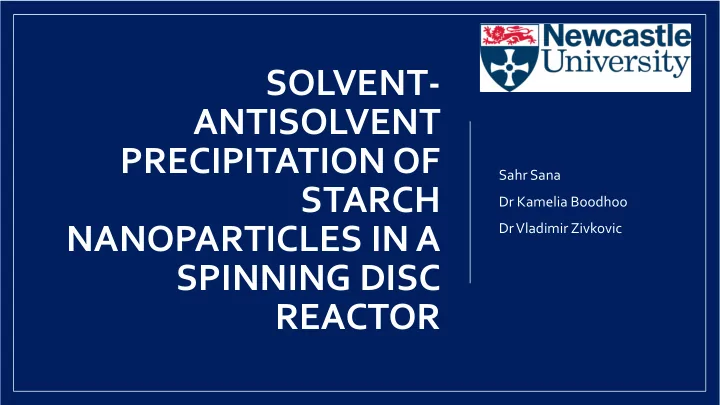

SOLVENT- ANTISOLVENT PRECIPITATION OF Sahr Sana STARCH Dr Kamelia Boodhoo Dr Vladimir Zivkovic NANOPARTICLES IN A SPINNING DISC REACTOR
Applications of starch nanoparticles Nanocomposite filler ▪ ▪ Enhance mechanical, barrier and thermal properties Wastewater treatment ▪ Remove organic pollutant ▪ Carrier for drug delivery ▪ systems Biodegradable, non-toxic ▪ Packaging ▪
Solvent-antisolvent precipitation: a brief literature review ▪ Dropwise addition of antisolvent to solvent-solute mixture ▪ Size of nanoparticles 50 – 200 nm [1] ▪ Limitations: • Adding drops of ethanol to avoid agglomeration may be time consuming ▪ No study of flow systems reported in literature NaOH NaOH Starch + + nano- Starch Starch particles [1] A. Hebeish, M.H. El-Rafie, M.A. EL-Sheikh, M.E. El-Naggar, Journal of Inorganic and Organometallic Polymers and Materials 24 (2014) 515-524.
Semi-batch process 1 % w/v starch, 800 RPM, 1 mL/s 2 % w/v starch, 800 RPM, 1 mL/s 500 nm 100 nm
Intensifying with SDR ▪ Applied to processes including: • Polymerisation • Crystallisation Feed Pipes • Catalytic reactions ▪ Characteristics of SDR • Creates thin films Reactor Disc Housing • Intensified micromixing (heated/cooled) • Short residence times • Narrow particle size distributions Product Product Collection Collection
The spinning disc reactor Disc Reactor housing
Results: Effect of total flow rate 14 . 4 nm 15 . 2 nm 15 . 1 nm 12 . 2 nm 8 . 1 nm Run 12 (Q T = 18 mL/s, 1:9, 1200 RPM) Run 8 (Q T = 6 mL/s, 1:9, 1200 RPM)
Results: Effect of total flow rate 50% Run 8 (Q T = 6 mL/s, 1:9, 1200 RPM) 45% 40% 35% Run 8 (QT= 6 mL/s, 1:9, 1200 RPM) 30% Run 12 (QT= 18 mL/s, 1:9, 1200 RPM) Frequency 25% 20% 15% 10% 5% 0% 0 10 20 30 40 50 60 70 80 90 100 110 120 Particle diameter (nm)
Conclusion ▪ Agglomerated particles produced in semi-batch experiments ▪ Continuous processing in the SDR has indicated the presence of smaller sized particles with narrower PSDs and reduced agglomeration.
Recommend
More recommend